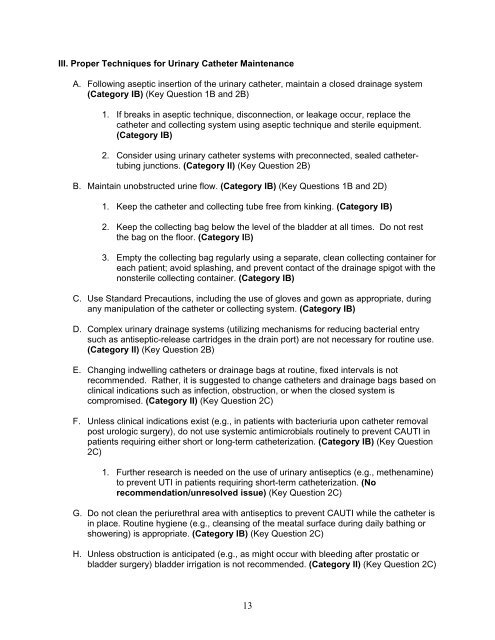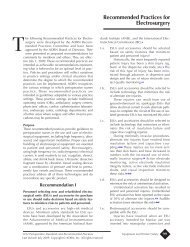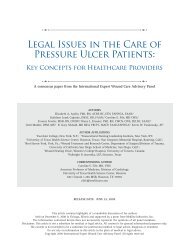2009 CAUTI guidelines - Centers for Disease Control and Prevention
2009 CAUTI guidelines - Centers for Disease Control and Prevention
2009 CAUTI guidelines - Centers for Disease Control and Prevention
You also want an ePaper? Increase the reach of your titles
YUMPU automatically turns print PDFs into web optimized ePapers that Google loves.
III. Proper Techniques <strong>for</strong> Urinary Catheter MaintenanceA. Following aseptic insertion of the urinary catheter, maintain a closed drainage system(Category IB) (Key Question 1B <strong>and</strong> 2B)1. If breaks in aseptic technique, disconnection, or leakage occur, replace thecatheter <strong>and</strong> collecting system using aseptic technique <strong>and</strong> sterile equipment.(Category IB)2. Consider using urinary catheter systems with preconnected, sealed cathetertubingjunctions. (Category II) (Key Question 2B)B. Maintain unobstructed urine flow. (Category IB) (Key Questions 1B <strong>and</strong> 2D)1. Keep the catheter <strong>and</strong> collecting tube free from kinking. (Category IB)2. Keep the collecting bag below the level of the bladder at all times. Do not restthe bag on the floor. (Category IB)3. Empty the collecting bag regularly using a separate, clean collecting container <strong>for</strong>each patient; avoid splashing, <strong>and</strong> prevent contact of the drainage spigot with thenonsterile collecting container. (Category IB)C. Use St<strong>and</strong>ard Precautions, including the use of gloves <strong>and</strong> gown as appropriate, duringany manipulation of the catheter or collecting system. (Category IB)D. Complex urinary drainage systems (utilizing mechanisms <strong>for</strong> reducing bacterial entrysuch as antiseptic-release cartridges in the drain port) are not necessary <strong>for</strong> routine use.(Category II) (Key Question 2B)E. Changing indwelling catheters or drainage bags at routine, fixed intervals is notrecommended. Rather, it is suggested to change catheters <strong>and</strong> drainage bags based onclinical indications such as infection, obstruction, or when the closed system iscompromised. (Category II) (Key Question 2C)F. Unless clinical indications exist (e.g., in patients with bacteriuria upon catheter removalpost urologic surgery), do not use systemic antimicrobials routinely to prevent <strong>CAUTI</strong> inpatients requiring either short or long-term catheterization. (Category IB) (Key Question2C)1. Further research is needed on the use of urinary antiseptics (e.g., methenamine)to prevent UTI in patients requiring short-term catheterization. (Norecommendation/unresolved issue) (Key Question 2C)G. Do not clean the periurethral area with antiseptics to prevent <strong>CAUTI</strong> while the catheter isin place. Routine hygiene (e.g., cleansing of the meatal surface during daily bathing orshowering) is appropriate. (Category IB) (Key Question 2C)H. Unless obstruction is anticipated (e.g., as might occur with bleeding after prostatic orbladder surgery) bladder irrigation is not recommended. (Category II) (Key Question 2C)13
















